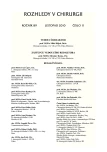Axillary Dissection in the Surgical Management of Invasive Breast Cancer in Postmenopausal Female Patients
Authors:
M. Marcinová; D. Lukčo; S. Krajníková; A. Vrzgula
Authors‘ workplace:
III. chirurgická klinika SZU, l. súkromná nemocnica, Nemocnica Košice Šaca a. s., Slovenská republika
prednosta: MUDr. Andrej Vrzgula, Ph. D.
Published in:
Rozhl. Chir., 2010, roč. 89, č. 11, s. 666-669.
Category:
Monothematic special - Original
Overview
The breast cancer is the most commonly diagnosed cancer worldwide and the leading cause of cancer mortality of women over 55 years of age. It is associated with more favorable tumor biology in erderly women, as indicated by increased hormone sensitivity, lower grades of proliferative activity and attenuated HER-2/neu receptor overexpression. The progress of breast cancer is less agressive in erderly women and the response to the adjuvant therapy is different too. According to the retrospective analysis the authors discussed the up-to-date role of axillary dissection in selected groups of postmenopauzal women with the early breast cancer (T1N0M0) and its impact on postoperative quality of everyday life.
Key words:
axillary dissection – early brest cancer – postmenopauzal women
Sources
1. Aponte-Rueda, M., Saade-Cárdenas, R., Saade-Aure, M. Endoscopic axillary dissection: A systemic review of the literature. The Breast, 18, 2009, 3, s. 150–158.
2. Bella, V., a kol. Karcinóm prsníka. Banská Bystrica: Advert, s.r.o., 2005, s. 82–95.
3. Bland, I. K., Copeland, E. M. The Breast – Comperhensive Management of Benign and Malignant Disorders. 3. vydanie. St. Louis Missouri: Sounders Elsevier, 2004, s. 896.
4. Brun, J., Rousseau, E., Belleannée, G., de Mascarel, A., Brun, G. Axillary lymphadenectomy prepared by fat and lymph node suctionin breast cancer. European Journal of Surgical Oncology, 24, 2009, č. 1, s. 17–20.
5. Crane-Okada, R., Wascher, R. A., Elashoff, D., Guliano, A. E. Long-term morbidity of sentinel node biopsy versus complete axillary dissection for unilateral breast cancer. Annals of Surgical Oncolology, 15, 2008, č. 7, s. 1996–2005.
6. Červinka, V., Šťastný, K., Havlíček, K., Vyhnánková, I., Vaňásek, J., Pavlíková, E., Rothrockel, P., Hácová, M. Naše zkušenosti s detekcí sentinelové uzliny. Rozhl. Chir., 83, 2004, č. 6., s. 217–220.
7. Diab, S. G., Eledge, R. M., Clark, G. M. Tumor characteristics and clinical outcome of erderly women with breast cancer. J. Natl. Cancer Inst., 2000; č. 92, s. 550–556.
8. Engel, J., Kerr, J., Schlessinger-Raab, A., et al. Quality of life following breast-conserving therapy or mastectomy: Results of 5-year prospectivive study. Breast Journal, 2004, č. 10, s. 223–231.
9. Estourgie, M. J., Guliano, A., Reintgen, D. S., Trafa, L. Percutaneus large core cut biopsy: a multiinstitutional study. Am. Soc. Brest Surg., 2004, č. 60, s. 427–430.
10. Fischer, B., et al. Twenty-year follow-up of a randomised trial comparing total mastectomy, lumpectomy and lumpectomy plus irradiation for the treatment of invasive breast cancer. N. Engl. J. Med., 2002, č. 347, s. 1233.
11. Gambazzi, F., Zuber, M., Oertli, D., et al. Small breast carcinomas: less axillary surgery? Swiss Surgery, 2000, č. 6, s. 116–120.
12. Gipponi, M., Basseti, C., Canavese, G., Gatturich, A., et al. Sentinel lymph node as a new marker for therapeutic planning in breast cancer patients. Surg. Oncol., 85, 2004, č. 3, s. 101–111.
13. Helms, G., Kühn, T., Moser, L., Remmel, E., Kreienberg, R. Shoulder-arm morbidity in patients with sentinel node biopsy and complete axillary dissection – data from a prospective randomised trial. Eur. J. Surg. Oncol., 35, 2009, č. 7, s. 696–701.
14. Husted Madsen, A., Haugaard, K., Soerensen, J., Bokmand, S., Friis, E., Holtveg, H., Peter-Garne, J., Horby, J., Christiansen, P. Arm morbidity following sentinel node biopsy or axillary lymph node dissection: a study from the Danish Breast Cdancer Cooperative Group. Breast, 17, 2008, č. 2, s. 138–147.
15. Chua, B., Ung, O., Taylor, R., Boyages, J. Is there a role for axillary dissection for patients with operable breast cancer in this era of conservatism? ANZ J. Surg., 72, 2002, č. 11, s. 786–792.
16. Langer, I., Kocher, T., Guller, U., Torhorst, J., Oertli, D., Harder, F., Zuber, M. Long-term outcomes of breast cancer patients after endoscopic axillary lymph node dissection: a prospective analysis of 52 patients. Breast Cancer Research and Threatment, 2005, č. 90, s. 85–91.
17. Veronesi, U., Pagenelli, G., Viale, G., et al. A randomized comparison of sentinel-node biopsy with routine axillary dissection in breast cancer. N. Engl. J. Med., 2003, č. 394, s. 546–553.
18. Verschraegen, C., Vinn-Hung, V., Cserni, G., Gordon, R., Royce M. E., Vlaston, G., Tai, P., Storme, G. Modeling the Effect of Tumor Size in Early Breast Cancer. Annals of Surgery, 2005, č. 241, s. 309–318.
19. Wágnerová, M., Berč, A. Karcinóm prsníka u gerontologických pacientok. Onkológia, 2009, č. 2, s. 84–88.
20. Zhu, L., Lam, C. K., Chow, L. W. Sentinel lymph node biopsy or detection of micrometastasis in bone marrow: which might be an alternative to axillary lymph node dissection in breast cancer patients? Asian Journal of Surgery, 27, 2004, č. 4, s. 279–283.
Labels
Surgery Orthopaedics Trauma surgeryArticle was published in
Perspectives in Surgery

2010 Issue 11
Most read in this issue
- Mucinous Adenocarcinoma of the Appendix – Case Report
- Abdominal Catastrophe – Abdominal Wall Defect Associated with Gastrointestinal Fistula – Strategy of Therapy
- Five-Year Follow up in Patients after Surgery for Clear Cell Renal Carcinoma
- Torsion of the Omentum – An Uncommon Cause of Acute Abdomen
